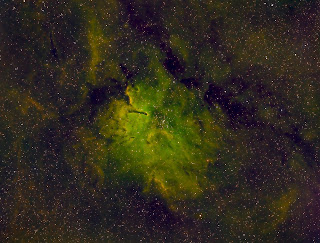Colorful stars, integrated flux nebulae, and a galaxy, what more can you ask for. The centerpiece of this image is spiral galaxy NGC 7497 located approximately 60 million light-years towards Pegasus. This almost edge-on galaxy stands out well and does show some detail much to my surprise given the size of my scope. This region also has faint clouds of interstellar dust which ride above the galactic plane and dimly reflect the Milky Way's combined starlight. These clouds are known has integrated flux nebulae and are commonly associated with molecular clouds. This region in home to the diffuse molecular cloud MBM 54, less than 1000 light-years years away. There appears to be other small galaxies scattered throughout this region as well.
Dates: 9-18-20, 9-19-20, 10-7-20, 10-8-20, 10-9-20, 10-14-20
NGC 7497
Home Monroe, CT
Dates: 9-18-20, 9-19-20, 10-7-20, 10-8-20, 10-9-20, 10-14-20
Camera: ZWO ASI1600MM-Pro
Telescope: Astro-Tech AT115EDT 115mm Refractor Telescope
Barlow: None
Focal Length: 805
f/7
Focal Reducer: AstroTech Field Flatterner/Focal Reducer
Mount: Orion Sirius
Filter Wheel: ZWO EFW 8 x 1.25"
Filter: ZWO L, R, G, B
Focuser: ZWO EAF
Autoguiding: ASI120 Mini attached to an Agena 50mm Guide Scope/ZWO 60mm Guidescope
Exposure: L 210 x 90, R 63 x 90, G 64 x 90, B 62 x 90
Gain: 139
Offset 21
Temp: 5 C
Processing: APT, NINA, PixInsight, Photoshop.
https://kurtzeppetello.smugmug.com/
http://astroquest1.blogspot.com/
http://youtube.com/c/AstroQuest1




